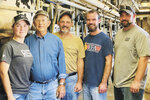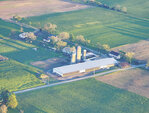


MERCERSBURG, Pa. — When a fire destroyed a central part of their farm in 2019, the Brake family chose to rebuild and take the farm in a new direction.
They automated milking, feeding and manure scraping with a trio of technology that includes two Lely Astronaut A5 robotic milking units, a Lely Vector feeding system and two Lely Discovery manure collectors.
A focus on robotic technology has increased efficiency and cow comfort at Oakleigh Farm near Mercersburg, where the Brakes milk 120 cows and farm 400 acres.
“The genetic potential of our cows is getting unleashed,” Matt Brake said. “In the past, we had a few cows hit 130 pounds of milk. Now, we’re able to hit 130-140 pounds so much easier and not overstress the cow.”
Owned by Brake’s parents, Glenn and Karen, the farm is in Franklin County, a dairy-rich region in the south central part of the state. The home farm dates to the 1800s and was established by Glenn’s family, who were horse traders until they began dairying in the late 1920s.
At 88 years old, Glenn’s dad, Ed, is active on the farm, raising replacement heifers. Brake’s brother, Jake, a full-time John Deere mechanic, works on the farm in his spare time. Brake’s sisters also pitch in when they come home. The Brakes have one hired hand who helps in the evenings and on Saturdays.
Four years ago, the farm’s bank barn, holding area and half of the main cow barn were lost to fire. Thankfully, all the animals were spared.
“It took a lot of family discussions to determine if we were going to continue or use this as a way to get out of the dairy industry,” Brake said. “My mom and dad wanted to see the cows come home, so did we kids, and so did my grandpa.”
Even before the fire, the Brakes had been gathering ideas for retrofitting robotic milkers into the barn. The Brakes decided to rebuild whether robots were the farm’s future or not because the parlor built in 1952 remained intact. But rather than continuing with a parlor that was nearly 70 years old, the Brake family chose a robotic milking system.
The cows were milked at a neighbor’s facility for seven months and then brought home July 17, 2020. For six weeks, they milked in their parlor until the robots were fired up Aug. 31.
The Brakes used to milk at 2:30 a.m. and 2:30 p.m. The family now lets the robots do that job, milking each cow an average of 2.8 times per day.
Previously, Brake’s sister, Katy, milked in the mornings before her off-farm job. She also dried off cows and was a key person in keeping the operation running, Brake said. Since switching to robots, Katy was free to pursue a head coaching job at the collegiate level.
“Now we feel like we can breathe, and we have some flexibility,” Brake said. “Sunday actually feels more like Sunday. We do chores, go to church, and we don’t have to draw straws for who has to start milking that afternoon. I can handle the majority of the work myself in the course of a day, assuming nothing crazy happens. That’s another huge benefit of the robot.”
Robots are arranged head-to-tail in a design that is a compilation of family ideas that came to fruition with help from Penn State Extension and Lely.
“We really love our barn design,” Brake said. “It’s an easy and convenient layout, and cow flow through the robots is great.”
Going from paper to electronic records, Brake said the milking technology also offers a better recordkeeping system for managing their herd.
“Robotics gave us the opportunity to jump forward in technology,” Brake said. “With the robots came the collar systems for heat detection and activity monitoring, which really benefited us.”
As before the fire, the Brakes house their herd in a compost-bedded pack barn. The new barn measures 348 feet by 80 feet. Cows are housed in one group. In addition, three pens on one end of the barn house breeding-age heifers, close-up cows and special needs animals. Herd size remained the same as the Brakes increased comfort levels for their registered Holstein herd.
“It’s been a rough couple years in the dairy industry, and now we have this beautiful barn to house our cows,” Brake said. “My dad and grandfather built a really solid genetic herd, and we’re proud of our cows and genetics. My dad has always been a believer in taking care of the cows and keeping them comfortable.”
Brake said the barn offers more space for cows on the bed pack and better ventilation from high-volume, low-speed fans and natural ventilation.
“We were overcrowded before,” Brake said. “You shoot for 100 square feet or more per cow in a bed pack barn, but we were down to around 65 square feet in the old barn. Now, we’re at 105-110 square feet per cow.”
The barn footprint did not grow much to garner this additional space, Brake said. Rather, existing space is utilized efficiently.
Brake uses a rototiller or chisel plow to work up the bed pack twice a day. He adds sawdust at least once a month in the summer and twice a month in winter. The pack is cleaned completely three times each year in January, March and late fall.
The Brakes feed a total mixed ration, but the family’s first dive into feeding a TMR did not occur until after the fire.
“I was the one mixing feed twice a day, six days a week and trucking it up to the other farm, so I really appreciate the Vector,” Brake said. “Its accuracy from a mixing standpoint and knowing precisely every day what the cows are eating has gained us a lot of efficiencies.”
The system collects feed from the farm’s silo conveyor system and then mixes and distributes it in the feed alley. To avoid having too much or too little feed in front of cattle, preset figures for feed height are programmed into the system for various groups of animals.
The manure collectors vacuum up waste, keeping walkways clean for cows. The collected manure is then emptied into the barn’s underground manure pit.
Entering their third full year in their facility, the Brake family is grateful for the improvements provided by robotics.
“It’s been quite the journey,” Brake said. “We were two months away from being debt-free the night of the fire, but I’m so fortunate that Dad was a huge believer in robotics. He was really excited about it, and the rebuild breathed fresh air into us. We went from a 1950s-era parlor to a 21st century dairy.”
Comments
No comments on this item Please log in to comment by clicking here